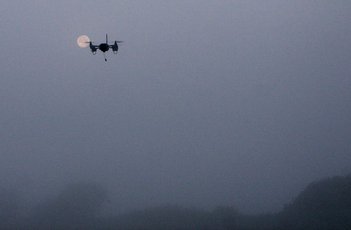Discovery Channel filmed Foulum scientists
A drone with technology that can detect wildlife in the field has attracted attention from the other side of the ocean. A Canadian television crew from Discovery Channel was on location an early morning in Central Jutland with scientists from the Department of Engineering at AU Foulum and the commercial company Sky-Watch in order to film research as it happens.

The full moon shines brightly in the otherwise dark, cool and quiet morning in the valley Nørreådalen in Central Jutland, Denmark. As the sun takes over the task of lighting up the day, the fog lifts her skirts from the dew-wet grass. The meadows exude an aura of mystique until nature shakes off the foggy blanket and unveils some of her secrets.
Nature is not the only presence. A television crew from the Candian Discovery Channel has come to film a project that scientists from the Department of Engineering at AU Foulum are collaborating on with the commercial company Sky-Watch in Støvring in northern Denmark. Using drones the project is well on its way to creating technology that can reveal some of nature’s morning secrets. The drone and its newly developed technology have raised so much interest on the other side of the Atlantic that the TV host Dan Riskin, who is known in Canada from the daily science program Daily Planet, has come all the way to Denmark together with a producer and photographer in order to shoot film about this exciting project.
Dangers lurk
One of the things that nature hides in the long grass is wildlife, which all too often gets mangled or killed in the large harvesters. The grass harvesters mow the meadows in the early summer. This is the same period as young deer fawns lie down flat to the ground in hopes of not being discovered. That is a good strategy to apply to avoid predators but very risky behaviour when an omnivorous harvester approaches. The result can be quite grusome.
The university scientists and the commercial company are working on deveoping a drone that uses heat sensors and cameras to spot warm-blooded animals in the tall gras. The aim is to develop the drone so it can identify the type of animal, send a message to the driver of the harvesting machine before he mows down the animal, and scare or lure the animal away using sounds that are tailor-made for the specific species.
Revealed by body heat
The moon takes its place in the back seat while the sun takes over the front row. Before rocks and other distracting elements on the ground are heated up by the sun the drone alights and sets off for work. Using its heat sensors it has been given the task of finding a dark brown bunny and a colourful pheasant that are hidden in the tall grass. They have been tethered in the tall grass today to give the drone something to work with.

Even with the full moon as the brightest light the drone can find wildlife using heat sensors. Photo: Janne Hansen

Television host, hunter, scientists and TV photographer work together to film a male pheasant that will be tethered in the meadow and thereafter detected by the drone. Photo: Janne Hansen
The drone hums like an oversized insect. It hovers in the air for the sake of the photographer before whizzing off in the direction of the rabbit and then the pheasant. Only a few minutes pass before the drone's heat sensors and new, special cameras have detected the animals. Up to now the drone has only been able to supply information that something unidentifiable was present.
This morning is the first time that the cameras are part of the action and show precisely what the drone has detected. It sends the pictures to a computer that the scientists have set up in their car trunk in the meadow. The pictures are viewed with fascination by the TV crew and scientists alike on the computer display. The TV crew are enthusiastic about being able to shoot research and new results as they happen.
Later in the day the drone ups it popularity when it finds a herd of wild deer in the tall grass. (See the video here.) Already before midmorning the drone and its people have ensured a series of great photo opportunities for the Canadian TV crew.
Efter cutting and editing the film wll be ready for broadcast in the autumn of 2013 on the program Daily Planet on Discovery Channel. Daily Planet is an hour-long popular science show that is broadcast daily on Canadian television.
“It is a feather in the cap for both the Department of Engineering and our communication staff at, among others, DCA – Danish Centre for Food and Agriculture, that this exciting research project has gained interest outside of our own community. It is technically exciting and challenging to make a success of it. It also has the interest of the general public. Deep scientific savvy combined with the aspect of practical application – that’s where we like to be. And it is extra fun when we can kindle the interest of media as far away as the North American Discovery Channel,” says the deputy head of the Department of Engineering Morten Dam Rasmussen.
Read more about the drone in the article “Drones spot wildlife in the field”.
The project is being carried out at the request of and in accordance with the agreement between Aarhus University and the Ministry of Food, Agriculture and Fisheries.
The drone was tested in an area by the river Nørreå where Aarhus University is participating in a project ”Vildtforvaltning i forbindelse med biomassehøst i ådal” ("Game management in connection with biomass harvest in river valley").
For more information please contact:
Senior scientist Rasmus Nyholm Jørgensen, e-mail: Rasmus.Jorgensen@agrsci.dk, mobile: (+45) 2162 8277 or deputy head of department Morten Dam Rasmussen, e-mail: mortend.rasmussen@agrsci.dk, telephone: (+45) 8715 7846, mobile: (+45) 2515 2755, both Department of Engineering
